Eco-Friendly Fibers Embedded Yarn Structure in High-Performance Fabrics to Improve Moisture Absorption and Drying Properties
Abstract
:1. Introduction
2. Experimental Section
2.1. Preparation of Yarn Specimens
2.2. Fabric Specimens Preparation
2.3. Evaluation of the Pore Size
2.4. Evaluation of Wicking Rate
2.5. Evaluation of Drying Rate
3. Results and Discussion
3.1. Fabric Pore Diameters According to the Yarn Structure
3.2. Absorption Characteristics of the Fabric Specimens
3.2.1. Drop Test by Transverse Wicking Evaluation
3.2.2. Bireck Test by Vertical Wicking Evaluation
3.3. Drying Characteristics of the Fabric Specimens
3.3.1. Drying Rate (min) at a Steady State
3.3.2. Drying Rate (g) at a Transient State
3.4. Correlation and Regression Analysis between Wicking and Drying Properties with Pore Diameter and Moisture Regain of the Fabrics
4. Conclusions
Funding
Institutional Review Board Statement
Data Availability Statement
Conflicts of Interest
References
- Kim, H.A. Moisture vapor permeability and thermal wear comfort of eco-friendly fibers embedded woven fabrics for high-performance clothing. Materials 2021, 14, 6205. [Google Scholar] [CrossRef] [PubMed]
- Slater, K. Environmental impact of polyester and polyamide textiles. In Polyesters and Polyamides, 1st ed.; Deopura, B.L., Alagirusamy, R., Joshi, M., Gupta, B., Eds.; Woodhead Publishing Limited: Cambridge, UK, 2008; pp. 171–199. ISBN 978-1845692988. [Google Scholar]
- Das, A.; Alagirusamy, R. Moisture transmission. In Science in Clothing Comfort, 1st ed.; Woodhead Publishing Ltd.: New Delhi, India, 2010; pp. 106–135. ISBN 978-8190800150. [Google Scholar]
- Cubric, I.S.; Skenderi, Z.; Havenith, G. Impact of raw material, yarn and fabric parameters, and finishing on water vapor resistance. Text. Res. J. 2013, 83, 1215–1228. [Google Scholar] [CrossRef] [Green Version]
- Das, B.; Das, A.; Kothari, V.K.; Fangueiro, R.; Araújo, M.D. Studies on moisture transmission properties of PV-blended fabrics. J. Text. Inst. 2009, 100, 588–597. [Google Scholar] [CrossRef]
- Gorjanc, D.Š.; Dimitrovski, K.; Bizjak, M. Thermal and water vapor resistance of the elastic and conventional cotton fabrics. Text. Res. J. 2012, 82, 1498–1506. [Google Scholar] [CrossRef]
- Kim, J.O.; Spivak, S.M. Dynamic moisture vapor transfer through textiles—Part II: Further techniques for microclimate moisture and temperature measurement. Text. Res. J. 1994, 64, 112–121. [Google Scholar] [CrossRef]
- Lee, S.S.; Obendorf, S.K. Statistical modeling of water vapor transport through woven fabrics. Text. Res. J. 2012, 82, 211–219. [Google Scholar] [CrossRef]
- Rego, J.M.; Verdu, P.; Nieto, J.; Blanes, M. Comfort analysis of woven cotton/polyester fabrics modified with a new elastic fiber, part 2: Detailed study of mechanical, thermo-physiological and skin sensorial properties. Text. Res. J. 2010, 80, 206–215. [Google Scholar] [CrossRef]
- Chen, Q.; Fan, J.; Au, Y.; Tang, M.K. Development and characterization of plant structured warp knitted fabric and garment. Fibers Polym. 2015, 16, 1430–1440. [Google Scholar] [CrossRef]
- Nyoni, A.B.; Brook, D. Wicking mechanisms in yarns–the key to fabric wicking performance. J. Text. Inst. 2006, 97, 119–128. [Google Scholar] [CrossRef]
- Patil, U.J.; Kane, C.D.; Ramesh, P. Wickability behaviour of single-knit structure. J. Text. Inst. 2009, 100, 457–465. [Google Scholar] [CrossRef]
- Fan, J.T.; Sarkar, M.K.; Szeto, Y.C.; Tao, X.M. Plant structured textile fabrics. Mater. Lett. 2007, 61, 561–565. [Google Scholar] [CrossRef]
- Fan, J.; Szeto, Y.C.; Sarkar, M.K. Fabric Simulating the Plant Structure for Moisture Management. U.S. Patent 8,486,847, 28 October 2008. [Google Scholar]
- Chen, Q.; Fan, J.; Sakar, M.; Jiang, G. Biomimetics of plant structure in knitted fabrics to improve the liquid water transport properties. Text. Res. J. 2010, 80, 568–576. [Google Scholar] [CrossRef]
- Chen, Q.; Fan, J.; Sakar, M.K.; Bal, K. Plant-based biomimetic branching structures in knitted fabrics for improved comfort-related properties. Text. Res. J. 2011, 81, 1039–1048. [Google Scholar] [CrossRef]
- Chen, Q.; Fan, J.; Sakar, M.K. Biomimetics of branching structure in warp knitted fabrics to improve water transport properties for comfort. Text. Res. J. 2012, 82, 1131–1142. [Google Scholar] [CrossRef]
- Sarkar, M.; Fan, J.; Szeto, Y.; Tao, X. Biomimetics of plant structures in textile fabrics for the improvement of water transport properties. Text. Res. J. 2009, 79, 657–668. [Google Scholar] [CrossRef]
- Beskisiz, E.; Ucar, N.; Demir, A. The effects of super absorbent fibers on the washing, dry cleaning and drying behavior of knitted fabrics. Text. Res. J. 2009, 79, 1459–1466. [Google Scholar] [CrossRef]
- Eskin, B.; Uçar, N.; Demir, A. Water vapor absorption properties of a novel filament composed of maleic anhydride polypropylene, polypropylene and super absorbent polymer. Text. Res. J. 2011, 81, 1503–1509. [Google Scholar] [CrossRef]
- Kim, H.A.; Kim, S.J. Physical properties and wear comfort of bio fiber-embedded yarns and their knitted fabrics according to yarn structures. Autex Res. J. 2019, 19, 279–287. [Google Scholar]
- Kim, H.A. Physical properties of ring, compact, and air vortex yarns made of PTT/wool/modal and wearing comfort of their knitted fabrics for high emotional garments. J. Text. Inst. 2017, 108, 1647–1656. [Google Scholar] [CrossRef]
- Zupin, J.; Hladnik, A.; Dimitrovski, K. Prediction of one- layer woven fabrics air permeability using porosity parameters. Text. Res. J. 2012, 82, 117–128. [Google Scholar] [CrossRef]
- Dubrovski, D.P. Volume porosity of woven fabrics. Text. Res. J. 2000, 70, 915–919. [Google Scholar] [CrossRef]
- Dubrovski, D.P.; Ziberna-sujica, M.M. The connection between woven fabric construction parameters and air permeability. Fibres Text. East. Eur. 1995, 3, 37–41. [Google Scholar]
- Jaksic, D.; Jaksic, N. Assessment of Porosity of Flat Textile Fabrics. Text. Res. J. 2017, 77, 105–110. [Google Scholar] [CrossRef]
- Kim, H.A.; Kim, S.J. Moisture and thermal permeability of the hollow textured PET imbedded woven fabrics for high emotional garments. Fibers Polym. 2016, 17, 427–438. [Google Scholar] [CrossRef]
- Su, C.; Fang, J.; Chen, X.; Wu, W. Moisture absorption and release of the profiled polyester and cotton composite knitted fabrics. Text. Res. J. 2007, 77, 764–769. [Google Scholar] [CrossRef]
- Katz, M. Synthetic Fiber Fabrics with Enhanced Hydrophilicity and Comfort. U.S. Patent 5,888,914, 30 March 1999. [Google Scholar]
- Kim, H.A. Water/moisture vapor permeabilities and thermal wear comfort of the Quadrilobal PET/bamboo/Lyocell included PET and PP composite yarns and their woven fabrics. J. Text. Inst. 2021, 112, 1940–1953. [Google Scholar] [CrossRef]
- Kim, H.A. Wear comfort of woven fabrics for clothing made from composite yarns. Fibers Polym. 2021, 22, 2344–2353. [Google Scholar] [CrossRef]
- ASTM F316-03; Standard Test Methods for Pore Size Characteristics of Membrane Filters by Bubble Point and Mean Flow Pore Test. American Society for Testing and Materials: West Conshohocken, PA, USA, 2019.
- AATCC 39; Evaluation of Wettability. American Association of Textile Chemists and Colorists: Durham, NC, USA, 1980.
- Harnett, P.R.; Mehta, P.N. A survey and comparison of laboratory test methods for measuring wicking. Text. Res. J. 1984, 51, 471–478. [Google Scholar] [CrossRef]
- JIS L 1907; Testing Methods for Water Absorbency of Textiles. Japanese Standards Association: Tokyo, Japan, 2020.
- JIS L 1096; Testing Methods for Woven and Knitted Fabrics. Japanese Standards Association: Tokyo, Japan, 2015.
- Ucar, N.; Beskisiz, E.; Demir, A. Design of a novel filament with vapor absorption capacity without creating any feeling of wetness. Text. Res. J. 2009, 79, 1539–1546. [Google Scholar] [CrossRef]
- Lomax, G.R. The design of waterproof, water vapour-permeable fabrics. J. Coat. Fabr. 1985, 15, 40–49. [Google Scholar] [CrossRef]
- Das, A.; Zimniewska, M.; Mal, R.D. Studies on cotton-acrylic bulked yarns produced from different spinning technologies: Part II—Fabric characteristics. J. Text. Inst. 2009, 100, 420–429. [Google Scholar] [CrossRef]
- Das, A.; Ishtiaque, S.M. Comfort characteristics of fabrics containing twist-less and hollow fibrous assemblies in weft. J. Text. Appar. Technol. Manag. 2004, 3, 1–7. [Google Scholar]
- Kim, H.A.; Kim, S.J. Flame retardant, anti-static and wear comfort properties of modacrylic/Excel®/anti-static PET blend yarns and their knitted fabrics. J. Text. Inst. 2019, 110, 1318–1328. [Google Scholar] [CrossRef]
- Kim, H.A.; Kim, S.J. Flame-retardant and wear comfort properties of modacrylic/FR-rayon/anti-static PET blend yarns and their woven fabrics for clothing. Fibers Polym. 2018, 19, 1869–1879. [Google Scholar] [CrossRef]
- Fangueiro, R.; Filgueiras, A.; Soutinho, F.; Meidi, X. Wicking behavior and drying capability of functional knitted fabrics. Text. Res. J. 2010, 80, 1522–1530. [Google Scholar] [CrossRef] [Green Version]
- Miller, B. Critical evaluation of upward wicking tests. Int. Nonwovens J. 2000, 9, 35–40. [Google Scholar] [CrossRef] [Green Version]
- Li, L.J.; Wang, Y.P.; Wang, G.; Cheng, H.T.; Han, X.J. Evaluation of properties of natural bamboo fiber for application in summer textiles. J. Fiber Bioeng. Inform. 2010, 3, 94–99. [Google Scholar]
- Yanilmaz, M.; Kalaoglu, F. Investigation of wicking, wetting and drying properties of acrylic knitted fabrics. Text. Res. J. 2012, 82, 820–831. [Google Scholar] [CrossRef]


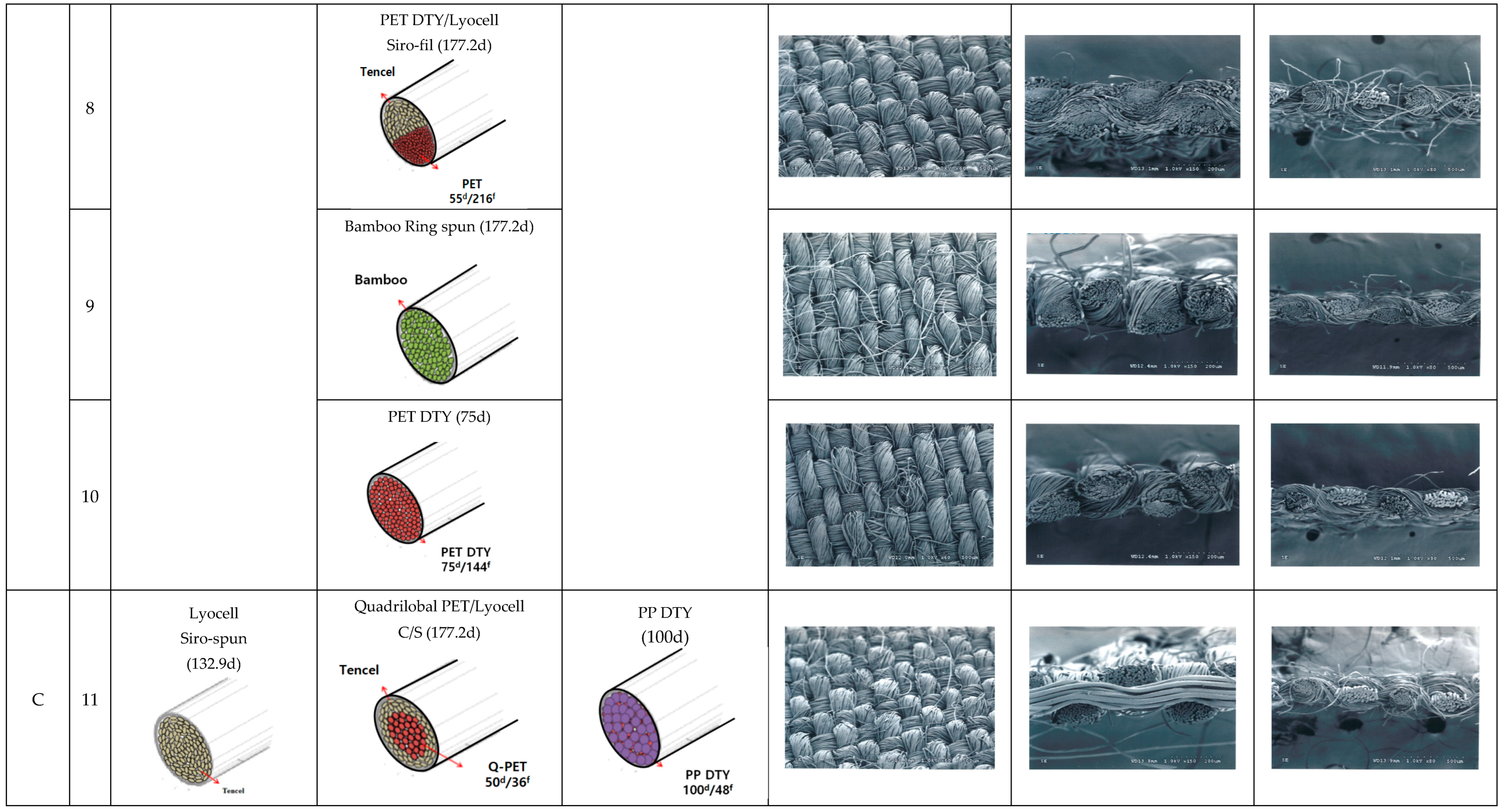
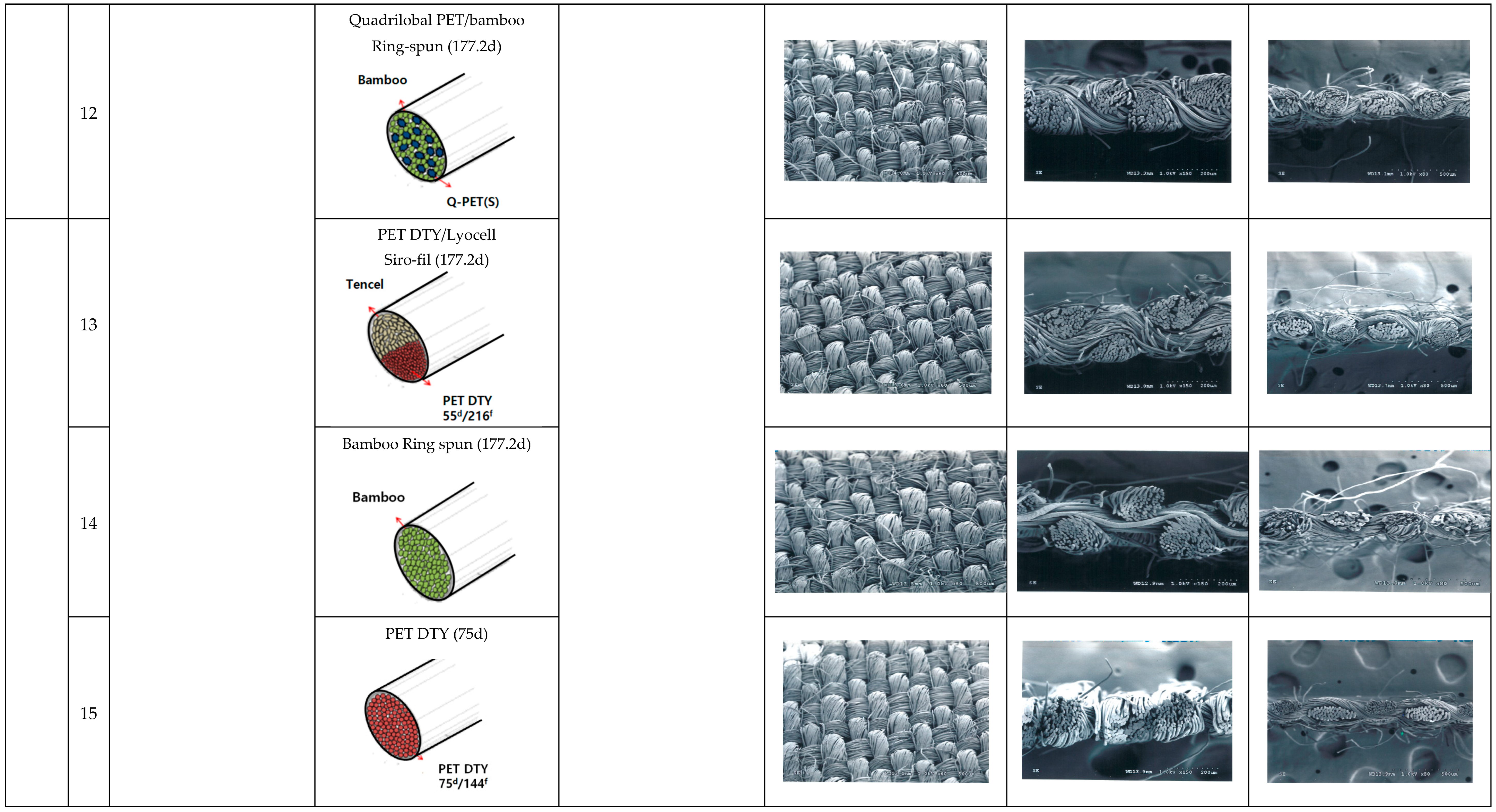
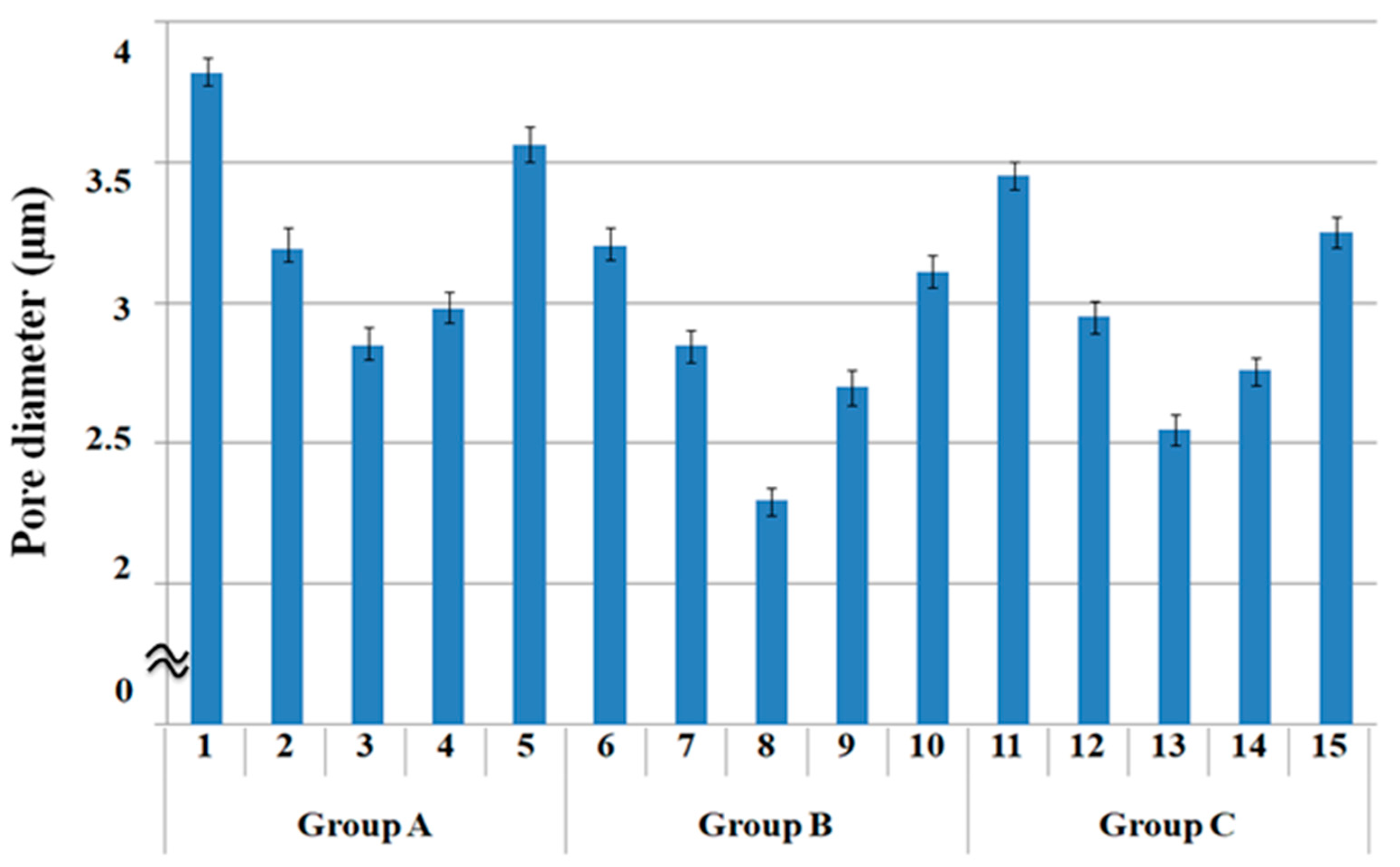
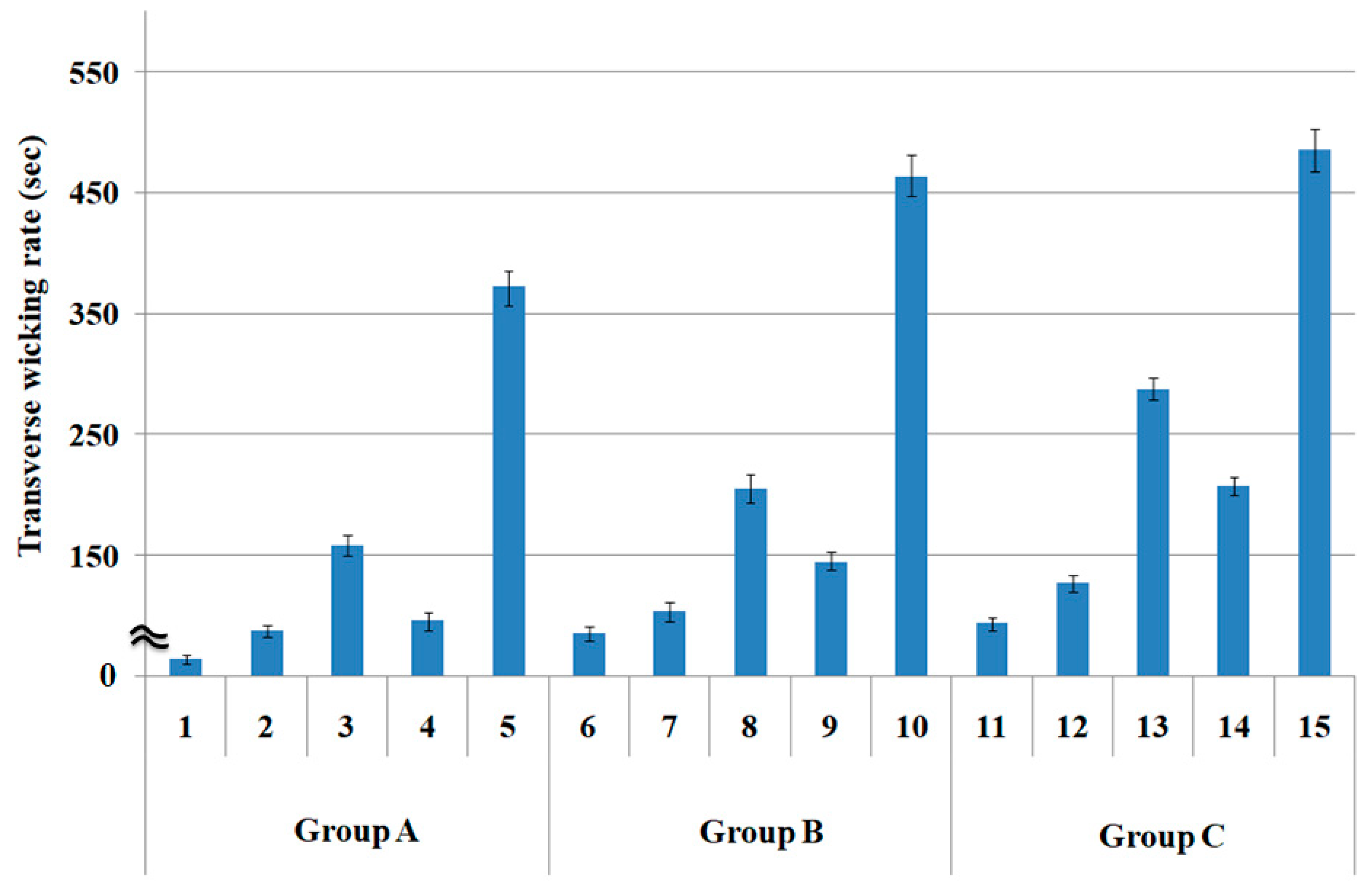
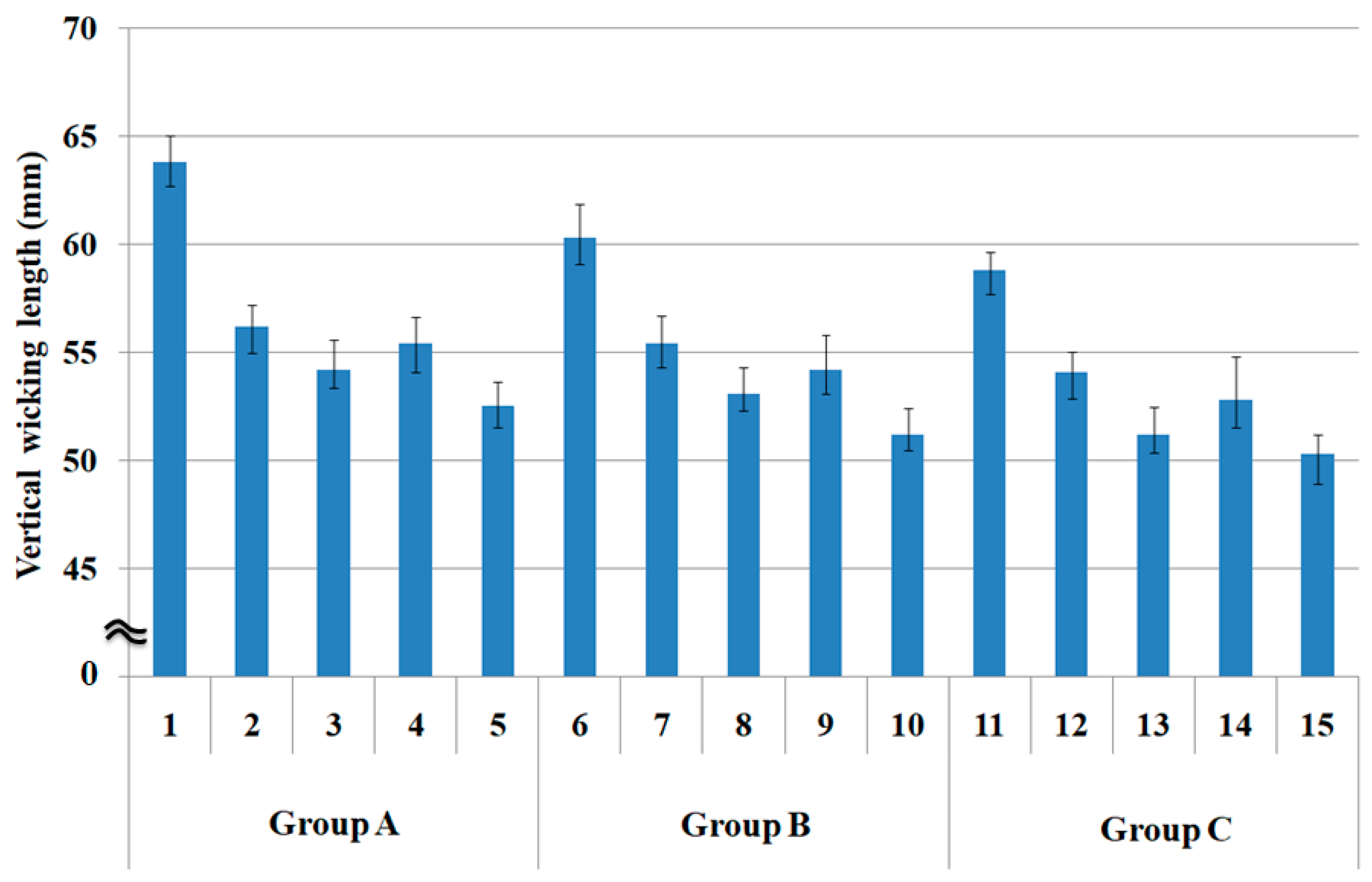
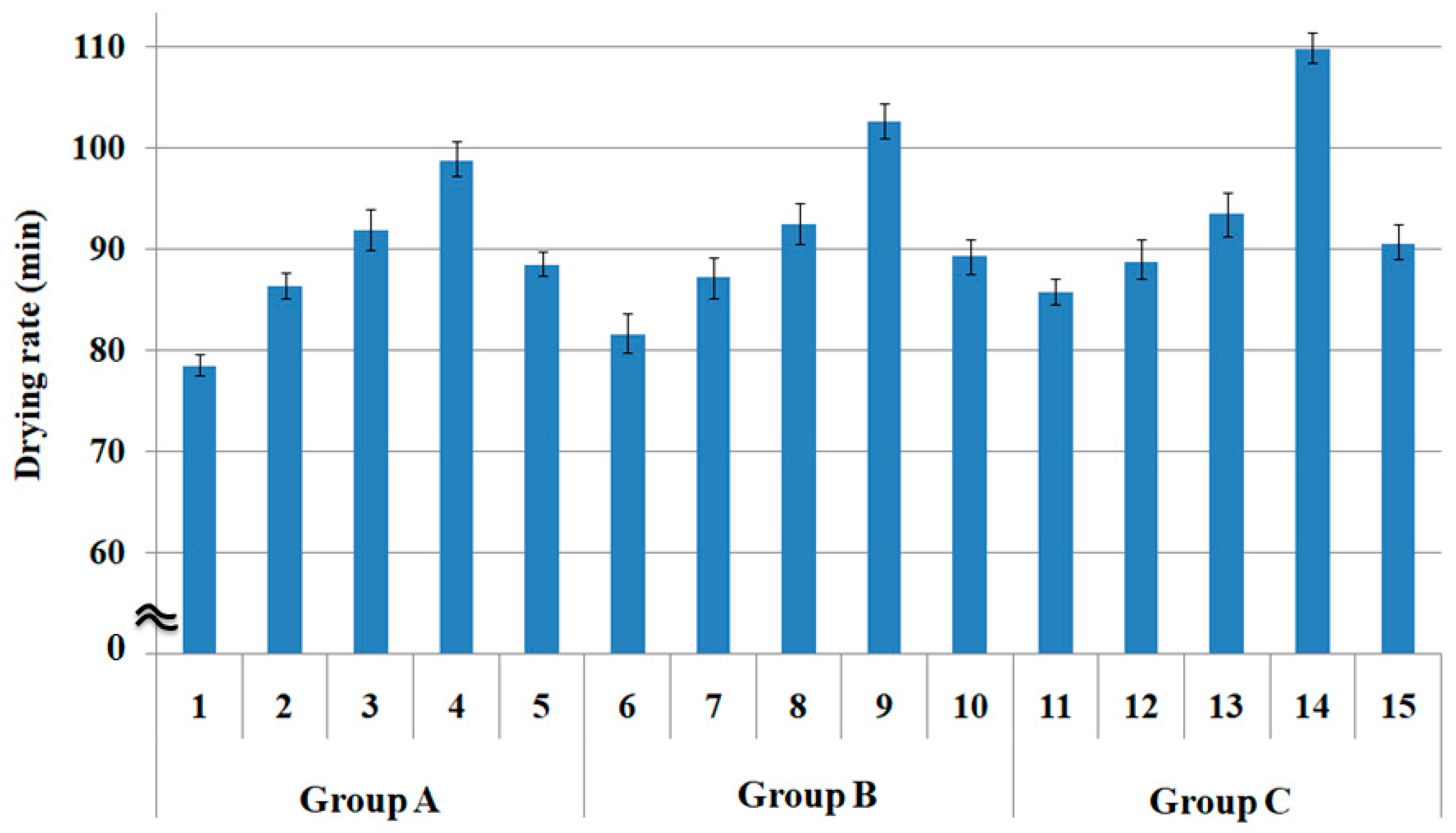
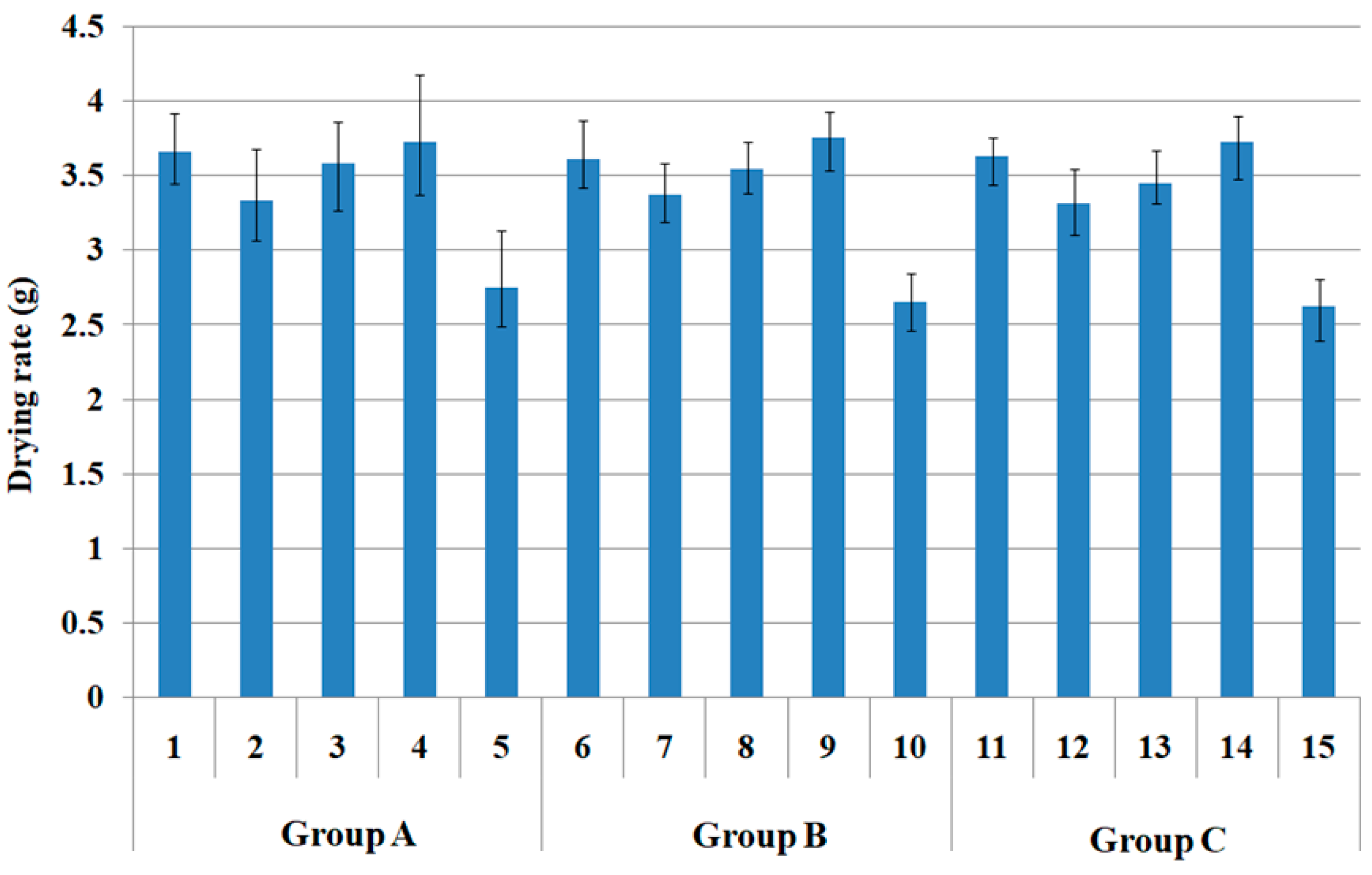
| Yarn Specimen No. | Yarn Type | Blend Ratio (%) | Spinning m-Method | Yarn No. (d) | Twist | Mechanical Property | ||
|---|---|---|---|---|---|---|---|---|
| TM (tpi/  ) ) | Spindle (rpm) | Strength (CN) | Breaking Strain (%) | |||||
| (1) | PP/Lyocell | PP:39.3 T: 60.7 | Sheath/core | 132.9 | 4.53 | 7000 | 247.5 | 8.8 |
| (2) | PET/Lyocell | P: 44.4 T: 55.6 | Siro-fil | 132.9 | 4.12 | 9000 | 349.3 | 12.9 |
| (3) | Lyocell | T: 100 | Siro-spun | 132.9 | 4.42 | 11,000 | 333.2 | 7.1 |
| (4) | Quadrilobal PET/ Lyocell | Q: 39.3 T: 60.7 | Sheath/core | 177.2 | 4.34 | 9000 | 253.6 | 14.8 |
| (5) | Quadrilobal PET/ Bamboo | Q: 48.6 B: 51.4 | Ring-spun | 177.2 | 3.82 | 12,000 | 376.8 | 14.1 |
| (6) | PET/Lyocell | P: 44.4 T:55.6 | Siro-fil | 177.2 | 4.12 | 9000 | 440.5 | 11.6 |
| (7) | Bamboo | B: 100 | Ring-spun | 177.2 | 3.82 | 12,000 | 382.6 | 9.2 |
| (8) * | Hi-multi PET | P: 100 | - | 75.0 | - | - | - | - |
| (9) * | PP filament | PP: 100 | - | 100 | - | - | - | - |
| Group | Fabric Specimen No. | Warp Yarn | Weft Yarn | Fabric Density (Ends, Picks/cm) | Weight (g/y) | Thickness (mm) | ||
|---|---|---|---|---|---|---|---|---|
| Yarn 1 | Yarn 2 | Wp | Wf | |||||
| A | 1 | PP/Lyocell Sheath/core (132.9d) | Quadrilobal PET/ Lyocell S/C (177.2d) | PP (100d) | 36.0 | 24.6 | 162 | 0.368 |
| 2 | Quadrilobal PET/ Bamboo spun (177.2d) | 162 | 0.345 | |||||
| 3 | PET/Lyocell Siro-fil (177.2d) | 162 | 0.341 | |||||
| 4 | Bamboo spun (177.2d) | 162 | 0.364 | |||||
| 5 | Hi-multi PET (75d) | 137 | 0.352 | |||||
| B | 6 | PET/Lyocell Siro-fil (132.9d) | Quadrilobal PET/ Lyocell S/C (177.2d) | PP (100d) | 36.0 | 24.6 | 160 | 0.396 |
| 7 | Quadrilobal PET/ Bamboo spun (177.2d) | 161 | 0.337 | |||||
| 8 | PET/Lyocell Siro-fil (177.2d) | 161 | 0.345 | |||||
| 9 | Bamboo spun (177.2d) | 161 | 0.345 | |||||
| 10 | Hi-multi PET (75d) | 137 | 0.294 | |||||
| C | 11 | Lyocell Siro-spun (132.9d) | Quadrilobal PET/ Lyocell S/C (177.2d) | PP (100d) | 36.0 | 24.6 | 158 | 0.380 |
| 12 | Quadrilobal PET/ Bamboo spun (177.2d) | 160 | 0.356 | |||||
| 13 | PET/Lyocell Siro-fil (177.2d) | 160 | 0.345 | |||||
| 14 | Bamboo spun (177.2d) | 161 | 0.349 | |||||
| 15 | Hi-multi PET (75d) | 133 | 0.301 | |||||
| Group | Fabric Specimen No. | Pore Diameter P (µm) | Wicking Rate | Drying Rate | Moisture Regain M (%) | ||||||||
|---|---|---|---|---|---|---|---|---|---|---|---|---|---|
| Transverse Wicking Rate W1 (s) | Vertical Wicking Length W2 (mm) | D1 (min) | D2 (g) | ||||||||||
| Mean | Dev. | Mean | Dev. | Mean | Dev. | Mean | Dev. | Mean | Dev. | Mean | Dev. | ||
| A | 1 | 3.82 | 0.100 | 64.2 | 1.5 | 63.8 | 2.4 | 78.5 | 2.1 | 3.66 | 0.47 | 28.3 | 3.1 |
| 2 | 3.19 | 0.088 | 87.5 | 2.7 | 56.2 | 2.2 | 86.4 | 2.6 | 3.33 | 0.61 | 27.2 | 2.7 | |
| 3 | 2.85 | 0.112 | 158.2 | 4.1 | 54.2 | 2.2 | 91.8 | 4.1 | 3.58 | 0.59 | 26.4 | 2.5 | |
| 4 | 2.98 | 0.110 | 96.3 | 1.8 | 55.4 | 2.6 | 98.8 | 3.5 | 3.72 | 0.81 | 30.2 | 3.7 | |
| 5 | 3.56 | 0.124 | 372.8 | 9.9 | 52.5 | 2.1 | 88.5 | 2.5 | 2.75 | 0.64 | 26.3 | 2.4 | |
| B | 6 | 3.20 | 0.104 | 86.1 | 2.5 | 60.3 | 2.8 | 81.6 | 3.9 | 3.61 | 0.45 | 30.2 | 3.6 |
| 7 | 2.85 | 0.115 | 103.7 | 1.8 | 55.4 | 2.4 | 87.2 | 4.0 | 3.37 | 0.39 | 28.5 | 3.2 | |
| 8 | 2.30 | 0.096 | 205.4 | 5.2 | 53.1 | 2.0 | 92.4 | 4.2 | 3.54 | 0.35 | 28.1 | 2.8 | |
| 9 | 2.70 | 0.121 | 144.6 | 3.7 | 54.2 | 2.8 | 102.6 | 3.5 | 3.75 | 0.39 | 32.4 | 3.5 | |
| 10 | 3.11 | 0.116 | 463.2 | 9.3 | 51.2 | 2.0 | 89.4 | 3.5 | 2.65 | 0.39 | 26.2 | 2.4 | |
| C | 11 | 3.45 | 0.100 | 94.3 | 2.2 | 58.8 | 2.0 | 85.8 | 2.6 | 3.63 | 0.32 | 34.4 | 4.2 |
| 12 | 2.95 | 0.116 | 127.6 | 2.8 | 54.1 | 2.2 | 88.8 | 3.9 | 3.31 | 0.45 | 34.2 | 4.5 | |
| 13 | 2.55 | 0.106 | 287.2 | 4.0 | 51.2 | 2.1 | 93.5 | 4.3 | 3.45 | 0.35 | 34.0 | 4.0 | |
| 14 | 2.76 | 0.094 | 207.1 | 3.5 | 52.8 | 3.3 | 109.8 | 3.1 | 3.72 | 0.42 | 36.7 | 5.1 | |
| 15 | 3.25 | 0.111 | 485.6 | 8.7 | 50.3 | 2.3 | 90.6 | 3.4 | 2.62 | 0.42 | 32.1 | 3.8 | |
| Pore Diameter (µm) | Transverse Wicking Rate (W1) | Vertical Wicking Length (W2) | Drying Rate (D1) | Drying Rate (D2) | Moisture Regain (M) | |
|---|---|---|---|---|---|---|
| Pore diameter (P, µm) | 1 | |||||
| Transverse wicking rate (W1, s) | −0.482 * | 1 | ||||
| Vertical wicking length (W2, mm) | 0.547 * | −0.751 * | 1 | |||
| Drying rate (D1, min) | −0.607 * | 0.146 | −0.566 * | 1 | ||
| Drying rate (D2, g) | −0.281 | −0.850 * | 0.541 * | 0.240 | 1 | |
| Moisture regain (M, %) | −0.226 | −0.112 | −0.090 | 0.474 | 0.348 | 1 |
| Wicking (y) | Regression Equation | R2 | p-Value |
|---|---|---|---|
| Vertical wicking length (mm) | y = 38.09 + 4.97 P − 0.16 M −0.185 D1 + 6.93 D2 | 0.92 ** | 1.76 × 10−5 < 0.01 |
| Transverse wicking rate (second) | y = 1021.2 + 20.0 P − 5.33 M −5.79 D1 + 421.8 D2 | 0.86 ** | 2.95 × 10−4 < 0.01 |
Disclaimer/Publisher’s Note: The statements, opinions and data contained in all publications are solely those of the individual author(s) and contributor(s) and not of MDPI and/or the editor(s). MDPI and/or the editor(s) disclaim responsibility for any injury to people or property resulting from any ideas, methods, instructions or products referred to in the content. |
© 2023 by the author. Licensee MDPI, Basel, Switzerland. This article is an open access article distributed under the terms and conditions of the Creative Commons Attribution (CC BY) license (https://creativecommons.org/licenses/by/4.0/).
Share and Cite
Kim, H.-A. Eco-Friendly Fibers Embedded Yarn Structure in High-Performance Fabrics to Improve Moisture Absorption and Drying Properties. Polymers 2023, 15, 581. https://doi.org/10.3390/polym15030581
Kim H-A. Eco-Friendly Fibers Embedded Yarn Structure in High-Performance Fabrics to Improve Moisture Absorption and Drying Properties. Polymers. 2023; 15(3):581. https://doi.org/10.3390/polym15030581
Chicago/Turabian StyleKim, Hyun-Ah. 2023. "Eco-Friendly Fibers Embedded Yarn Structure in High-Performance Fabrics to Improve Moisture Absorption and Drying Properties" Polymers 15, no. 3: 581. https://doi.org/10.3390/polym15030581






